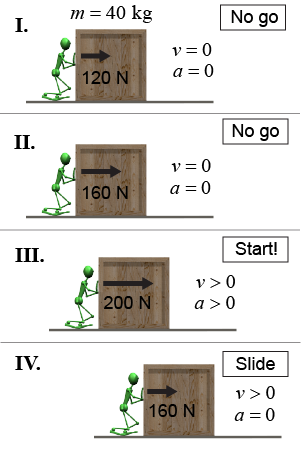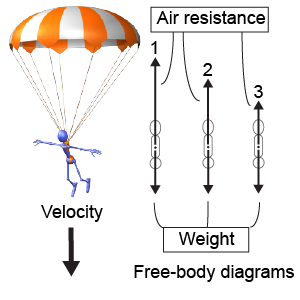|
The term friction covers a wide range of forces, all of which either oppose motion or oppose the forces that would cause motion. Static friction prevents an applied force from making an object slide. Kinetic friction creates a force that acts opposite to the direction of sliding motion. We model the force of friction as a coefficient times the normal force acting between moving surfaces. The concept of friction also extends to air resistance and viscosity, both of which resist an object’s motion through a fluid. 
|
|
static friction, coefficient of static friction, coefficient of kinetic friction, lubrication, sliding friction, rolling friction, coefficient of rolling friction, viscosity, drag coefficient
|
|
|
|
Review problems and questions |
|

- A mover is pushing on a 40 kg crate that rests upon a hardwood floor. Her efforts proceed as follows:
- She applies a horizontal 120 N force.
The crate does not move. - She next applies a 160 N force.
The crate remains motionless. - She increases her push to 200 N.
The crate just begins to slide. - She returns to a 160 N push.
The crate slides at a constant speed. Questions: - What is the maximum static friction force (in newtons)?
- What is the kinetic friction force (in newtons)?
- What is the coefficient of static friction?
- What is the coefficient of kinetic friction?


|
Answer: - The maximum static friction force is 200 N.
- The kinetic friction force is 160 N.
- The coefficient of static friction is μs = 0.51.
- The coefficient of kinetic friction is μk = 0.41.
Solution: - The maximum static friction force is 200 N. Static friction can have any value up to a maximum given by Ff = μsFN. When that maximum is exceeded even by a tiny bit, the net force becomes nonzero and the crate begins to accelerate, as shown in step c.
- The kinetic friction force is 160 N strong. Since the crate is sliding in step d, the kind of friction at work is kinetic friction. The crate, however, is not accelerating. This means that the net force upon the crate is zero, and the force of kinetic friction is just as strong as the applied force.
- The coefficient of static friction is μs = 0.51.
Asked: coefficient of static friction μs
Given: crate mass m = 40 kg; maximum applied force that friction could resist Ff = 200 N
Relationships: Fw = mg; Ff = μsFN
Solution: The crate’s weight is Fw = mg = (40 kg)(9.8 N/kg) = 392 N The normal force equals the weight because the crate remains on the floor, so FN = Fw = 392 N The static friction and pushing forces are equal just before the crate begins to slide, so Ff = Fpush = 200 N Use the definition of static friction and substitute values to get: 200 N = μs × 392 N Dividing both sides by 392 N then yields μs = 0.51. - The coefficient of kinetic friction is μk = 0.41. Follow the same steps as in the solution for static friction, but instead of using a friction force of 200 N, use 160 N. Why? The mover only had to push with a force of 160 N to keep the crate moving at a constant speed once motion had begun.

|

- A skydiver jumps from an airplane and falls toward Earth. His instructor tells him to open his parachute. When he does so, the force of air resistance pushes upon his parachute, and the cords pull up on him. His fall slows down and gradually he reaches terminal velocity. The diagrams show three moments during this process; the lengths of the force vectors indicate how strong the forces are.
- Why does the skydiver slow down when the parachute is opened?
- Which of the three diagrams corresponds to terminal velocity, and why?


|
- The skydiver slows down because the net force upon him is upward, while his motion is downward. Applying Newton’s second law tells us that his acceleration is in the same direction as the net force. This means that the acceleration points upward at this early stage. Whenever acceleration and velocity are in opposite directions, an object’s speed is reduced.
- Diagram 3 corresponds to terminal velocity. A falling object at terminal velocity is not accelerating. This means that the net force on the object is zero. Diagram 3 is the only one with a zero net force on the skydiver.

|
Take a Quiz |
| |
|

